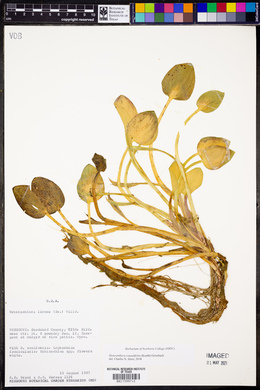Heteranthera rotundifolia
|
|
|
|
Family: Pontederiaceae
Round-Leaf Mud-Plantain, more...roundleaf mudplantain
|
Plants annual. Vegetative stems submersed with elongate inter-nodes, or if emersed at early age, then procumbent. Flowering stems 2-12 cm, distal internode 1-6 cm. Sessile leaves submersed, forming basal rosette; blade linear to oblanceolate, thickened, 2.4-5 cm × 2-4 mm. Petiolate leaves floating or emersed; stipule 1-5 cm; petiole 3-11 cm; blade round to oblong, 1-5 cm × 5-25 mm, length equaling (or, on young plants, greater than) width, base cordate to truncate, apex obtuse. Inflorescences 1-flowered; spathes 1-2.8 mm, glabrous. Flowers opening within 1 hour after dawn, wilting by midday; perianth blue or white, salverform, tube 11-29 mm, limbs essentially actinomorphic, lobes narrowly elliptic, 5.2-18.2 mm, proximal lobe longer, distal central lobe with lateral flanges toward base; stamens unequal, lateral stamens 2.8-8 mm, central stamen 3.9-8.5 mm; filaments linear, curved downward apically, glandular-pubescent; style glabrous. Seeds 8-15-winged, 0.5-1 × 0.3-0.6 mm. 2n = 14. Flowering Jun--Oct. Shallow water or exposed mud of ephemeral pools, roadside ditches, small ponds; 0--2800 m; Ariz., Calif., Colo., Kans., Ky., Mo., Nebr., N.Mex., Okla., S.Dak., Tex.; West Indies; Central America; South America (except Chile, French Guiana, Guyana, Peru, Suriname); naturalized in Italy. Heteranthera rotundifolia is closely related to H. limosa and has been considered conspecific with it by many, including D. S. Correll and H. B. Correll (1972), who noted differences in stem development but did not recognize them taxonomically. Close study of reproduction and seedling development (C. N. Horn 1988) has revealed other differences, besides yet others in flower morphology (cf. the descriptions). Seedlings of H. rotundifolia have flexible petioles and commonly develop elongate stems, while those of H. limosa have rigid petioles, even in deep water, and rarely develop elongate stems.
Plant: Annual or facultative perennial aquatic herb; vegetative stem submersed with elongate internodes or emersed and procumbent Leaves: SESSILE LEAVES few, submersed, thickened, green on the abaxial surface, linear to oblanceolate, the apex obtuse; petiolate leaves floating or emersed, round to oval, 1-5 cm long, 5-25 mm wide, the base cordate to truncate, the apex obtuse to acute, the petiole flexible on floating leaves, rigid on emersed leaves INFLORESCENCE: 1-flowered Flowers: perianth salverform, blue or white, the tube 11-29 mm long, the lobes narrowly elliptic, obtuse at apex, 5.2-18.2 mm long, the lower central lobe larger, the upper central lobe with lateral flanges toward the base; stamens of two sizes, the lateral 2.8-8.0 mm long, with yellow, oblong anthers 0.4-2.6 mm long; central stamen 3.9-8.5 mm long with a sagittate, blue or yellow anther 1.3-3.9 mm long; mature pollen grains separating Fruit: glabrous; anthers widely ovate to lanceolate, yellow, purple or white; ovary incompletely 3-locular; ovules few to many. FRUIT an elongate capsule with longitudinal dehiscence. SEEDS many, 0.5-1.0 mm long, the testa with longitudinal wings and cross striae between wings Misc: Ponds and ditches; up to 1600 m (4800 ft); Aug.-Oct REFERENCES: Horn, Charles N. 1998 Pontederiaceae. J. Ariz. - Nev. Acad. Sci. 30(2): 133. Much like no. 3 [Heteranthera limosa (Sw.) Willd.]; aerial lvs with floating or emergent, relatively broad and blunt blade, commonly nearly or fully as broad as long, obtuse or rounded above, rounded or subcordate at base; spathe closely clasping the fl; perianth-segments 3 above, 2 lateral and spreading, and one below, the central upper one with lateral flanges in the proximal one-fourth; lateral stamens with distally incurved filaments; 2n=14. Exposed mud-flats or in shallow water of ephemeral pools, roadside ditches, and small ponds; Mississippi R. drainage from Ky. to S.D., s. to S. Amer., and in s. Ariz. and w. Mex. Gleason, Henry A. & Cronquist, Arthur J. 1991. Manual of vascular plants of northeastern United States and adjacent Canada. lxxv + 910 pp. ©The New York Botanical Garden. All rights reserved. Used by permission. |












































































